This past week we have had Hymenocallis in bloom! This is the time for "Big Fatty," also known as Hymenocallis imperialis, to bloom. It's also when some of the smaller Mexican species bloom. This week we saw blooms on Hymenocallis guerreroensis, H. durangoensis, and H. glauca. I see buds on H. eucharidifolia as well. While the Mexican dwarf species tend to all look somewhat similar, Hymenocallis imperialis has a very unique look.
Hymenocallis imperialis
As I recall, this species was first collected in some old lady's front yard in Mexico. I'm a little vague on the details, as I wasn't there; but for a long time its name was simply "Big Fatty." If it should be classified in the Mexicana Group, it is probably the largest Hymenocallis in that group by far. Personally, it looks to me more like one of the Tropical group from Central America and northern South America in the lowlands.
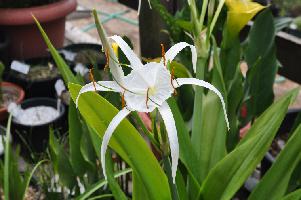
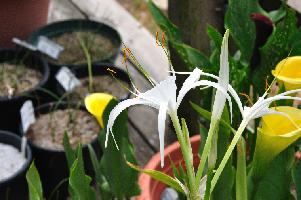
Hymenocallis imperialis
The staminal cup is like a wide funnel, and reaches 50 mm or about 2 inches across. The tepals (petals and sepals) are about 11 mm (less than a half inch) wide and about 11 cm (over 4 inches) long. The floral tube (from the ovary to the point where the tepals start to separate) is 105 to 110 mm (about 4 to 4½ inches) long. The height of the inflorescence (i.e., peduncle plus the flowers) is about 60 cm (24 inches).
The glossy, bright green leaves are 65-70 mm wide by about 55 cm long. It is deciduous, losing its leaves in my greenhouse each winter. I haven't tested its hardiness, but I fully expect that it would be killed by a hard frost and certainly if the ground froze around the bulb.
Hymenocallis guerreroensis
A typical member of the group of dwarf species found in Mexico, this one was discovered by the late Dr. Thad Howard in Guerrero. I don't have a very good picture of guerreroensis. It bloomed ahead of the others and I almost missed its bloom entirely.
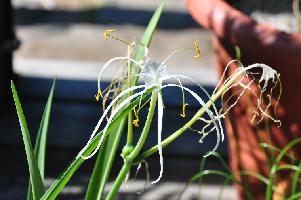
Hymenocallis guerreroensis
This has the floral tube 95 mm long, and the straight tube is characteristic of this species. The staminal cup is narrow and elongated -- somewhat trumpet shaped -- and the neck of the cup curves. The tepals are quite narrow. It could easily be mistaken for the following species. The height of the inflorescence is about 34 cm (ca. 13 inches). It has somewhat glaucous foliage.
Hymenocallis durangoensis
Another dwarf in the Mexican Alliance, this one was found by Thad Howard in Durango. The specific name may be "durangoensis" or simply "durangensis." I found one version in one index, the other in a different index.
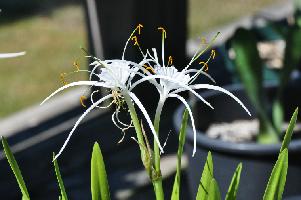
Hymenocallis durangoensis
The floral tube is 60 mm long, about 2½ inches more or less, and slightly curved. The staminal cup is small, compared to imperialis, and the tepals very narrow. The bloom stalk grows about 36 cm. (ca. 14 in.) tall. The leaves are plain green (not glaucous), with a slight twist in the outer third.
Hymenocallis glauca
This was discovered by Herbert, and is a dwarf in the Mexican group. It is a perky looking plant when in bloom, and Thad Howard told me the bulbs got to be as big as grapefruit. Mine have not, perhaps because they grow in pots no bigger than 2-gallon size. The specific name comes from the broad, glaucous leaves. This is one of my favorites.
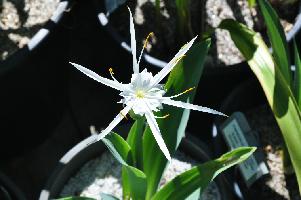
Hymenocallis glauca
The leaves are broad, but narrow toward the base until they are almost petiolate. And of course they have the matt, grayish blue-green color that gives them their name. The staminal cups open to 40 mm across, and are almost flat. The floral tube is 105-115 mm long (about 4¼-4¾ inches) long. The tepals are 3 to 6 mm (1/8 to ¼ inch) wide and 65-70 mm long (2½-2¾ inches). The inflorescence varies from ca. 30 to 40 cm. (12 to 16 inches) in height.
Hymenocallis glauca is reminiscent of H. eucharidifolia, especially the flowers and leaf shape. However, eucharidifolia has bright green leaves and prefers dappled shade, whereas glauca has glaucous leaves and tolerates full sun quite well.
Good gardening, from here in central Indiana
Jim
<shieldsgardens@gmail.com>
Look up technical terms in the Glossary of Plant Biology